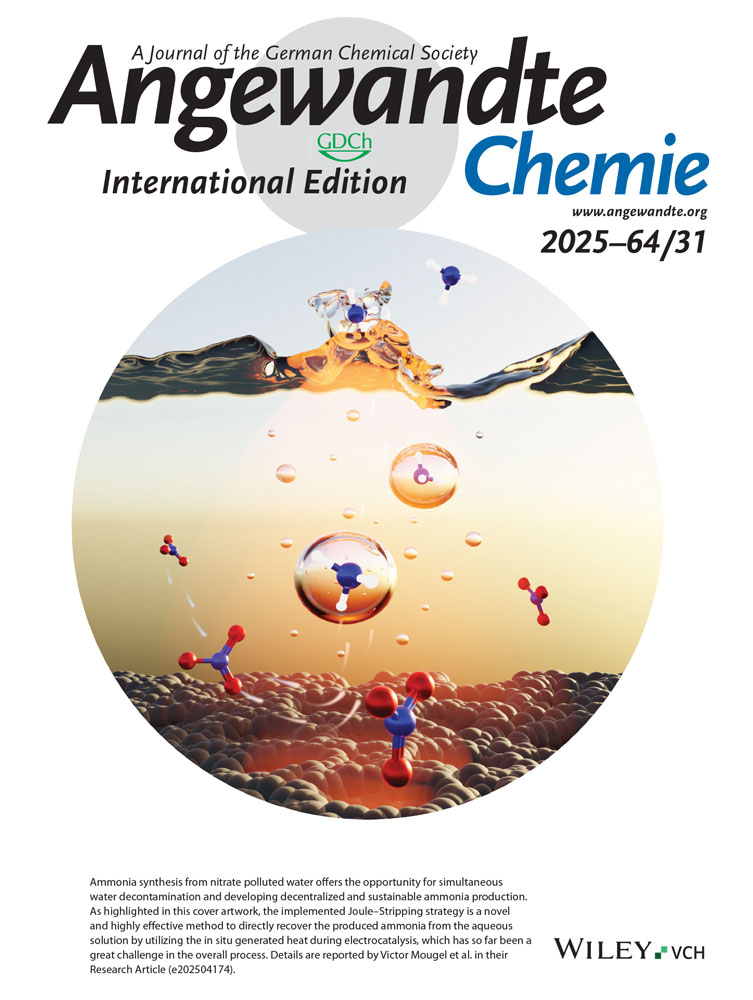Spontaneous Growth of Highly Conductive Two-Dimensional Single-Crystalline TiSi2 Nanonets†
Sa Zhou
Department of Chemistry, Merkert Chemistry Center, Boston College, 2609 Beacon Street, Chestnut Hill, MA 02467 (USA), Fax: (+1) 617-552-2705 http://www2.bc.edu/∼dwang
These authors contributed equally to this work.
Search for more papers by this authorXiaohua Liu Dr.
Department of Chemistry, Merkert Chemistry Center, Boston College, 2609 Beacon Street, Chestnut Hill, MA 02467 (USA), Fax: (+1) 617-552-2705 http://www2.bc.edu/∼dwang
These authors contributed equally to this work.
Search for more papers by this authorYongjing Lin
Department of Chemistry, Merkert Chemistry Center, Boston College, 2609 Beacon Street, Chestnut Hill, MA 02467 (USA), Fax: (+1) 617-552-2705 http://www2.bc.edu/∼dwang
Search for more papers by this authorDunwei Wang Dr.
Department of Chemistry, Merkert Chemistry Center, Boston College, 2609 Beacon Street, Chestnut Hill, MA 02467 (USA), Fax: (+1) 617-552-2705 http://www2.bc.edu/∼dwang
Search for more papers by this authorSa Zhou
Department of Chemistry, Merkert Chemistry Center, Boston College, 2609 Beacon Street, Chestnut Hill, MA 02467 (USA), Fax: (+1) 617-552-2705 http://www2.bc.edu/∼dwang
These authors contributed equally to this work.
Search for more papers by this authorXiaohua Liu Dr.
Department of Chemistry, Merkert Chemistry Center, Boston College, 2609 Beacon Street, Chestnut Hill, MA 02467 (USA), Fax: (+1) 617-552-2705 http://www2.bc.edu/∼dwang
These authors contributed equally to this work.
Search for more papers by this authorYongjing Lin
Department of Chemistry, Merkert Chemistry Center, Boston College, 2609 Beacon Street, Chestnut Hill, MA 02467 (USA), Fax: (+1) 617-552-2705 http://www2.bc.edu/∼dwang
Search for more papers by this authorDunwei Wang Dr.
Department of Chemistry, Merkert Chemistry Center, Boston College, 2609 Beacon Street, Chestnut Hill, MA 02467 (USA), Fax: (+1) 617-552-2705 http://www2.bc.edu/∼dwang
Search for more papers by this authorThis work was financially supported by Boston College. We are grateful to Prof. J. Kong and Y.-P. Hsieh at MIT for their generous help in carrying out Raman experiments. E. Shaw at MIT provided assistance in XPS experiments. Dr. D. Wang helped with TEM.
Graphical Abstract
Net result: Two-dimensional nanonets form spontaneously in a chemical vapor deposition reaction. All beams in the nanonet are single-crystalline nanobelts that are connected by 90° joints. The nanonets are roughly 15 nm thick and a few micrometers long and wide (see pictures for three images at different tilting angles), and they assume a C49 TiSi2 structure.
Supporting Information
Supporting information for this article is available on the WWW under http://www.wiley-vch.de/contents/jc_2002/2008/z802744_s.pdf or from the author.
Please note: The publisher is not responsible for the content or functionality of any supporting information supplied by the authors. Any queries (other than missing content) should be directed to the corresponding author for the article.
References
- 1L. Manna, D. J. Milliron, A. Meisel, E. C. Scher, A. P. Alivisatos, Nat. Mater. 2003, 2, 382.
- 2D. Wang, F. Qian, C. Yang, Z. H. Zhong, C. M. Lieber, Nano Lett. 2004, 4, 871.
- 3D. Wang, Y. Bunimovich, A. Boukai, J. R. Heath, Small 2007, 3, 2043.
- 4I. Gur, N. A. Fromer, C. P. Chen, A. G. Kanaras, A. P. Alivisatos, Nano Lett. 2007, 7, 409.
- 5D. Wang, C. M. Lieber, Nat. Mater. 2003, 2, 355.
- 6S. P. Murarka, D. B. Fraser, A. K. Sinha, H. J. Levinstein, IEEE Trans. Electron Devices 1980, 27, 1409.
- 7J. Chen, J. P. Colinge, D. Flandre, R. Gillon, J. P. Raskin, D. Vanhoenacker, J. Electrochem. Soc. 1997, 144, 2437.
- 8P. Ritterskamp, A. Kuklya, M.-A. W. Stkamp, K. Kerpen, C. Weidenthaler, M. Demuth, Angew. Chem. 2007, 119, 7917;
10.1002/ange.200701626 Google ScholarAngew. Chem. Int. Ed. 2007, 46, 7770.
- 9Y. N. Xia, P. D. Yang, Y. G. Sun, Y. Y. Wu, B. Mayers, B. Gates, Y. D. Yin, F. Kim, Y. Q. Yan, Adv. Mater. 2003, 15, 353.
- 10C. M. Lieber, MRS Bull. 2003, 28, 486.
- 11P. Gao, Z. L. Wang, J. Phys. Chem. B 2002, 106, 12653.
- 12J. Y. Lao, J. G. Wen, Z. F. Ren, Nano Lett. 2002, 2, 1287.
- 13A. G. Kanaras, C. Sonnichsen, H. T. Liu, A. P. Alivisatos, Nano Lett. 2005, 5, 2164.
- 14M. J. Bierman, Y. K. A. Lau, A. V. Kvit, A. L. Schmitt, S. Jin, Science 2008, 320, 1060.
- 15H. Yan, R. He, J. Johnson, M. Law, R. J. Saykally, P. Yang, J. Am. Chem. Soc. 2003, 125, 4728.
- 16S. Pavasupree, S. Ngamsinlapasathian, Y. Suzuki, S. Yoshikawa, J. Nanosci. Nanotechnol. 2006, 6, 3685.
- 17C. W. Peng, T. Y. Ke, L. Brohan, M. Richard-Plouet, J. C. Huang, E. Puzenat, H. T. Chiu, C. Y. Lee, Chem. Mater. 2008, 20, 2426.
- 18Z. W. Pan, Z. R. Dai, Z. L. Wang, Science 2001, 291, 1947.
- 19E. I. Givargizov, J. Cryst. Growth 1975, 31, 20.
- 20T. Wang, S.-Y. Oh, W.-J. Lee, Y.-J. Kim, H.-D. Lee, Appl. Surf. Sci. 2006, 252, 4943.
- 21B. Xiang, Q. X. Wang, Z. Wang, X. Z. Zhang, L. Q. Liu, J. Xu, D. P. Yu, Appl. Phys. Lett. 2005, 86.
- 22S. Zhou, X. H. Liu, Y. J. Lin, D. W. Wang, unpublished results.
- 23J. Du, P. Y. Du, P. Hao, Y. F. Huang, Z. D. Ren, G. R. Han, W. J. Weng, G. L. Zhao, J. Phys. Chem. C 2007, 111, 10814.
- 24J. Hyeongtag, C. A. Sukow, J. W. Honeycutt, G. A. Rozgonyi, R. J. Nemanich, J. Appl. Phys. 1992, 71, 4269.
- 25F. Meinardi, L. Moro, A. Sabbadini, G. Queirolo, Europhys. Lett. 1998, 44, 57.
- 26G. L. Kenneth, Rep. Prog. Phys. 2005, 68, 855.
- 27C. J. Kim, K. Kang, Y. S. Woo, K. G. Ryu, H. Moon, J. M. Kim, D. S. Zan, M. H. Jo, Adv. Mater. 2007, 19, 3637.
- 28A. L. Schmitt, L. Zhu, D. Schmeisser, F. J. Himpsel, S. Jin, J. Phys. Chem. B 2006, 110, 18142.
- 29R. Beyers, R. Sinclair, J. Appl. Phys. 1985, 57, 5240.
- 30M. Ekman, V. Ozolins, Phys. Rev. B 1998, 57, 4419.





